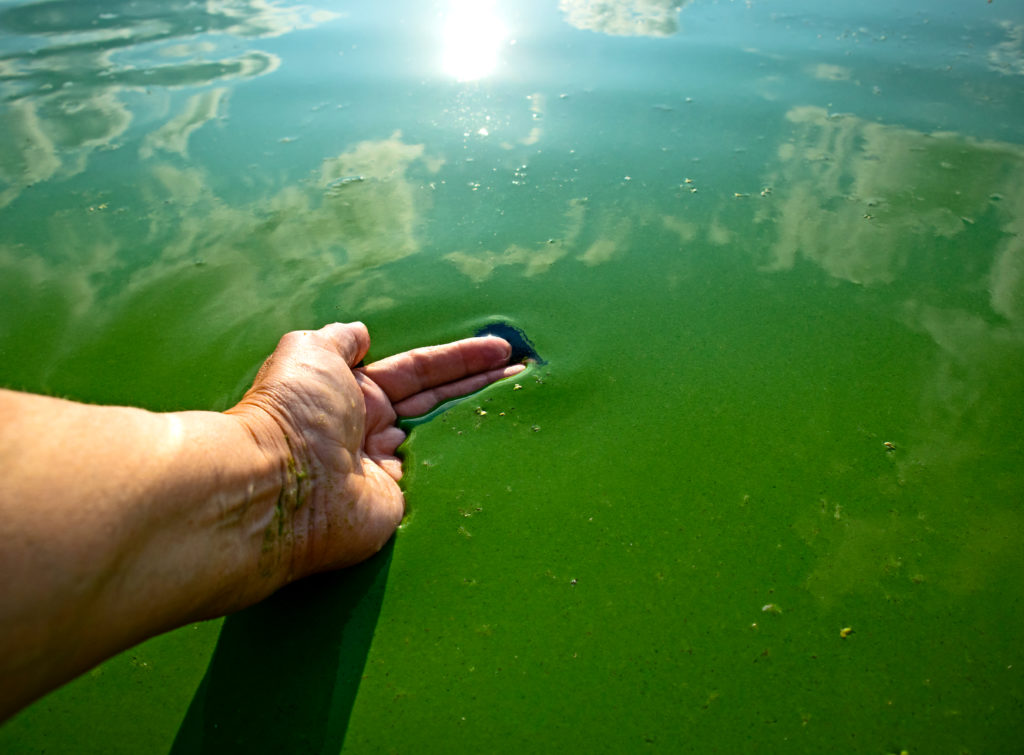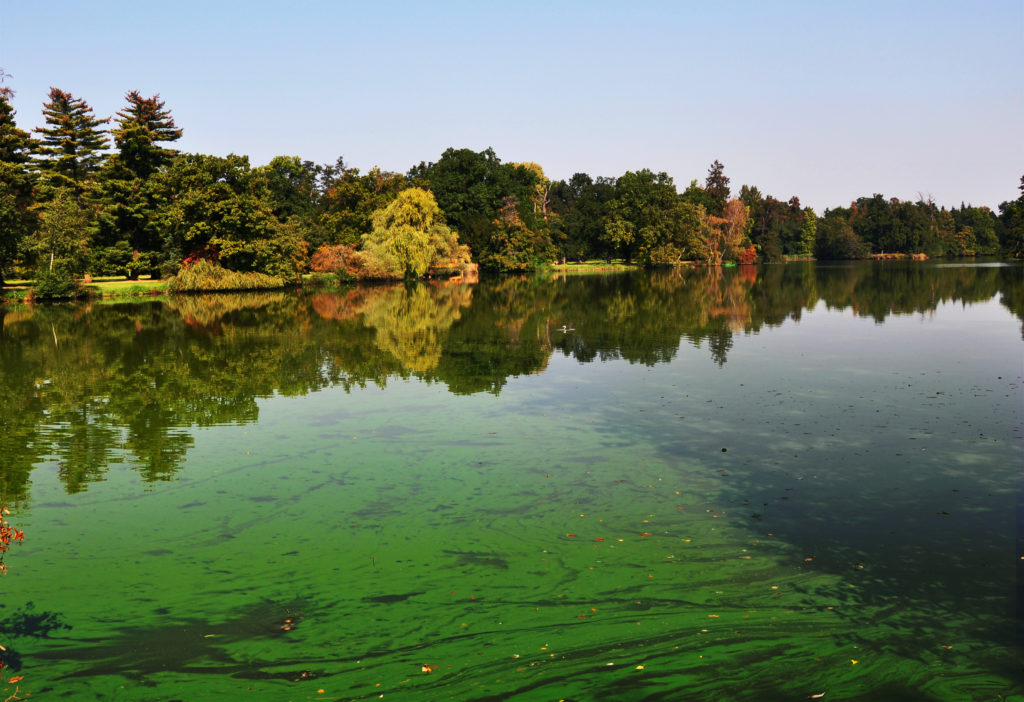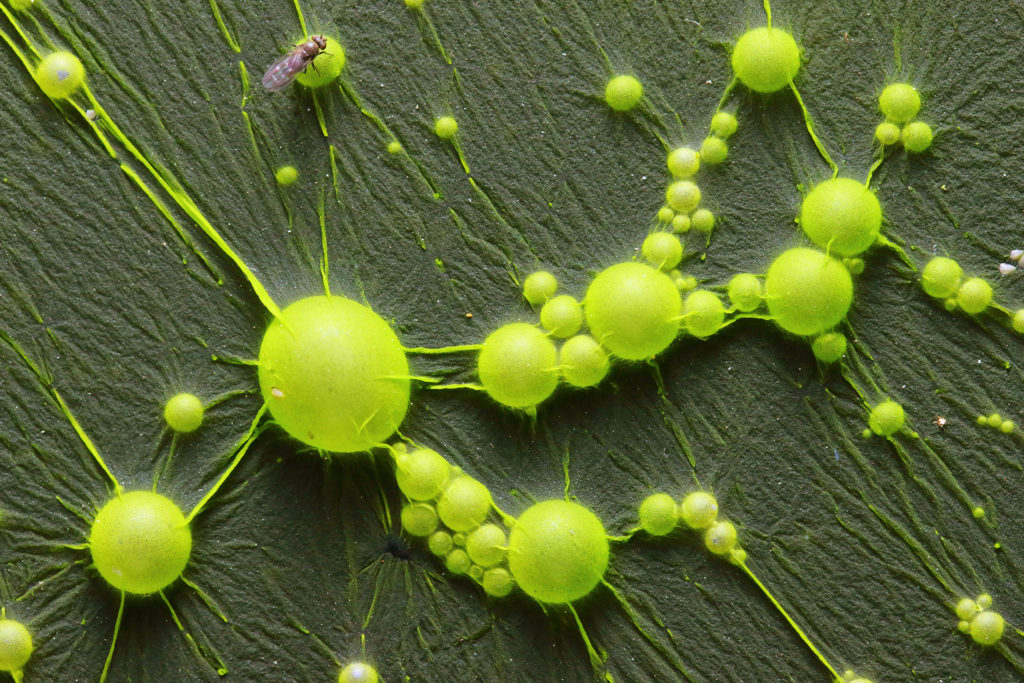By: Isabela Claret Torres, MSc, Ph.D.
Cyanobacteria are prokaryotic bacteria that make photosynthesis. This is not new, other bacteria can make photosynthesis, but cyanobacteria have chlorophyll, something that just the eukaryotic algae and higher plants have. They are also called blue-green algae and was formerly classified as algae in the division Cyanophyta or Myxophyceae (Cole 1994, Wetzel 2001). Their name derives from the pigment phycocyanin that with other pigments give their blue-green color (Cole 1994). For many years and till now there is a discussion in the scientific community in how to classify these organisms, as algae or bacteria. And there is a fight among phycologists and microbiologist in where they fit better.
Glue-Green Algae
Cyanobacteria (blue-green algae) are the Earth’s oldest known oxygen-producing organisms, with fossil remains dating back approximately 3.5 billion years (Schopf 2000). The cyanobacteria are true bacteria with simple prokaryotic cell structure, lacking certain membranous structures, including nuclear membrane. They also lack mitochondria and chloroplasts. The chloroplasts of other algae and plants originated from cyanobacteria by endosymbiosis (Wetzel 2001). Endosymbiosis is a symbiotic relationship where one organism lives inside the other. Many prokaryotic cells were internalized by an ancestral eukaryotic cell resulting in the formation of chloroplasts and mitochondria.
Symbiosis
Symbiosis is a relationship between two organisms of different species being the relationship positive or harmful to one of the species. They are photoautotrophs as they use light as an energy source, water as electron donor and carbon dioxide as a carbon source. These organisms have enzymatic and pigment capabilities to photosynthesize under oxygenated conditions as higher plants (Wetzel 2001).
The organisms can be unicellular, filamentous or colonial and have a mucilage sheath, in all forms individual or colonial. Cyanobacteria have many differential characteristics that make them better competitors for nutrient and carbon sources than any other algae. Due to this they outcompete other algae species and can become the dominant in a lake, river or ocean.

Heterocyst
One important characteristic is the presence of a differentiated cell called Heterocyst. Heterocyst’s cells fixate the nitrogen (N2) from the atmosphere giving to these organisms’ evolutionary advantage in relation to other algae groups. This is a special cell with a special membrane that block the presence of oxygen while allowing dissolved carbon into the cell to participate in the nitrogen fixation. The reason for this is because the enzyme responsible for nitrogen fixation, the nitrogenase, is inactivated by oxygen (Wetzel 2001).
This is one advantage that these groups have over the other algae that needs to get their nitrogen through dissolved inorganic forms from the water competing with all other organisms. When there is nitrogen limitation in the system cyanobacteria can overcome this by fixing N2 from the atmosphere. Not all cyanobacteria have heterocyst’s, but all can fix N2. The ones that lack this special cell overcome this by making photosynthesis during the day and fixing nitrogen during the night. Instead of having a structure separation they have temporal separation of photosynthesis and nitrogen fixation.
Another important characteristic of cyanobacteria is their ability to store phosphorus as polyphosphate inside the cell. Phosphorus can be, in most cases, the most limiting nutrient for algae and other microorganisms’ growth. Cyanobacteria avoid this limitation by having storage of polyphosphate. They accumulate phosphate when it is available inside the cell as polyphosphate. When there is phosphorus limitation, they break down the polyphosphate and use it for its metabolism.
Gas Vacuoles
Other important characteristic of these organisms is the presence of the gas vacuoles, with gas vesicles. With this they are able to control their position in the water column. When they need nutrients they compress the vacuoles empty them of gas and sink to the hypolimnion (link with the lake article) where is a nutrient rich area. When they need to fixate carbon and make photosynthesis they fill up with gas and float to the surface of the water to acquire light. This is a huge advantage as they can be on top of other algae winning the competition for light and shading other species of algae (Lee 1999).
Bicarbonate
Cyanobacteria are able to use bicarbonate (HCO3–) as a carbon source instead of carbon dioxide (CO2). Algae compete for CO2 to make photosynthesis as they compete for light and nutrients. The cyanobacteria can overcome this competition by using HCO3–. This is special important in alkaline (high pH) lakes where carbon is in mainly in the form of HCO3–. Besides chlorophyll a (is the pigment responsible for capturing the light the energy source for photosynthesis), the cyanobacteria have other pigments to capture the light. So, they are able to use the light in different wavelengths making an advantage in relation to other algae groups. They are also able to capture light when there is shading (Lee 1999).
Toxicity
Other important issue with these organisms is their capability of producing toxins, some of them deadly for animals and humans. In terms of their toxicological target, cyanobacterial toxins are hepatotoxins, neurotoxins, cytotoxins, dermatoxins and irritant toxins. Hepatotoxins are more common and prevalent than neurotoxins. The neurotoxins such as anatoxin-a, anatoxin-s and saxitoxin, can lead to death due to respiratory arrest caused by failure of the muscle diaphragm. Hepatotoxins, like microcystins, cylindrospermopsins and nodularins, can cause liver bleeding. Clinical signs include weakness, vomiting, diarrhea, and cold extremities (Lee 1999). Recently it was described a compound called BMAA in nearly all cyanobacteria tested. It has been hypothesized that BMAA maybe the possible cause of the amyotrophic lateral sclerosis, Parkinson-dementia complex.
Affects on Animals & Humans
It can affect animals and human beings that ingest the water or fisheries that accumulate these toxins in their tissue leading to health issues or even death (O’Neil et al. 2012). The presence of cyanobacteria with possible production of toxins is a great problem in large scale municipal water supplies and for aquaculture. In 1996 in Brazil, at the city of Caruaru (Pernambuco State) at a clinic 116 (89%) of 131 patients experienced visual disturbances, nausea, vomiting, and muscle weakness, following routine hemodialysis treatment. Subsequently, 100 patients developed acute liver failure. As of December 1996, 52 of the deaths could be attributed to the presence of microcystins in the lake water used for the hemodialysis. They also produce substances that can cause odor and taste to the water again being a problem for water supply.
Climate Change & Cyanobacteria
Cyanobacteria have higher temperature optima for growth and photosynthesis and can become a problem with the climate change. Climate change can favor these organisms to grow out of control and dominate the water bodies due to temperature change and highly available CO2. When there is this rapidly and intense growth of the cyanobacteria it is called a bloom. Cyanobacteria blooms cause many problems that I will discuss later in a eutrophication article and can be a source of taste, odor and toxins. With climate change the cyanobacteria bloom will be widely spread and more common event and can become a huge problem for water supply, lakes, rivers and reservoirs. The usual water treatment can take out the cyanobacteria, but has to adjust its treatment to try to remove the cyanotoxins, odor and taste of the water. The next pictures show blooms of cyanobacteria.
Cyanobacteria in Australia
Gaget et al. (2017) study the benthic cyanobacteria as a source of toxins in Australian drinking water reservoir. Sediment core samples were collected from a total of twenty locations within three Australian drinking-water reservoirs: Location 1 and Location 2 in South Australia and Location 3 in New South Wales, using a custom-made core sampler (50 mm diameter). The samples were analyzed for cylindrospermopsin and microcystin. The benthic biofilms sampled in this study had diverse filamentous cyanobacteria, mostly non-heterocystous genera. The genera found were: Anabaena (benthic form), Calothrix and Nostoc from the Nostocales and Geitlerinema, Leptolyngbya, Limnothrix, Lyngbya, Oxynema, Phormidium and Pseudanabaena.
Human Exposure to Cyanobacteria
Out of all the isolates purified during this study, three tested positive for the production of hepatotoxins in the ELISA: one isolate produced cylindrospermopsin and two produced microcystin. Water treatment facilities are likely remove most of the toxins, preventing human exposure by ingestion. Nonetheless, treatment processes need to be adjusted (i.e. activated carbon dose) to cope with high loads of algal metabolites or other challenges. In the absence of routine monitoring for benthic cyanobacteria, these modifications cannot be put in place.
This work represents the first evidence of hepatotoxin production by benthic cyanobacteria in temperate Australian drinking water reservoirs (i.e. in opposition to tropical areas studied previously). While most treatment plants can presumably remove most of the toxins from the water, the lack of knowledge about toxin production by benthic cyanobacteria largely underestimates the risk to human and animal health and does not allow the adaptation of treatment which might be necessary.
Cyanobacteria in Canada
Bartosiewicz et al. (2019) studied the effects of climate change and episodic heat events on cyanobacteria in a eutrophic polymictic lake. The studied lake, Lake St. Augustin, is located on the outskirts of Quebec City, Canada. It is a small (0.63 km2) and shallow (average depth of 3.5m) lake. For the study they integrated detailed results from a natural experiment comprising an average-wet year (2011) and one with heatwaves (2012), a long-term meteorological dataset (1960–2010), historical phosphorus concentrations and sedimentary pigment records, to determine the mechanistic controls of cyanobacterial blooms.

Algae Blooms
Enhanced stratification along with reduced wind speed during summers with heat waves, as compared to a more average year, lead to intensified warming of surface waters in a shallow polymictic eutrophic lake. Surface warming fosters development of high phytoplankton biomass, which, under reduced carbon inputs, is conducive to persistent CO2 depletion in the epilimnion. Buoyant cyanobacteria produce massive blooms when warm surface waters of strongly stratified (link to lake article) the lake become CO2 depleted. In polymictic lakes, synergistic mechanisms may catalyze cyanobacterial blooms once a certain threshold in warming is reached, while carbon inputs are reduced and the water column is sufficiently stable to allow epilimnetic CO2 depletion. This effect was responsible for proliferation of cyanobacteria in the lake and will likely result in more frequent blooms in the future.
Cyanobacteria in the United States
Schulte et al. (2022) studied the natural and anthropogenic influences on benthic cyanobacteria in streams of the northeastern United States. Cyanobacterial abundance in stream biofilms is typically related to single or a limited set of environmental factors, mainly light availability, water temperature, and nutrient concentrations. However, these factors may act synergistically with watershed characteristics and other stressors, such as anthropogenic pollutants, to affect cyanobacteria. The authors investigated the influence of multiple regional and local variables on the abundance of benthic cyanobacterial genera in streams using all subsets generalized additive modeling.
The authors examined watershed factors (topography, geology, and climate) alongside in-stream factors (geomorphology, hydrology, pH, specific conductance, nutrients, organic contaminants, and dissolved metals) from 76 sites along an urban gradient in the northeast United States. Each genus responded to a distinct combination of environmental variables, demonstrating strong intergeneric variation in environmental selection of realized niches. Four of the 7 potentially toxigenic genera were positively influenced by water temperature or nutrients. Nonetheless, watershed characteristics, streamflow, and/or other water quality pollutants were equally or more influential for the potentially toxigenic genera.
Cyanobacteria & Environmental Factors
Additionally, the relationships between cyanobacteria abundance and environmental factors varied in shape and direction across many genera. In particular, with increasing concentrations of herbicides, polychlorinated biphenyls, or metals, the abundance of roughly half of the affected genera decreased, while the others increased. The results emphasize the need to consider variables beyond those that are most frequently measured or implicated.
Carbon Offsets
Carbon offsets are a reduction or removal of emissions of carbon dioxide or other greenhouse gases made in order to compensate for emissions made elsewhere. Offsets reduce the overall emission of greenhouse gases into the atmosphere. They are a sometimes tradable commodity, with a market price set by supply and demand. The carbon offset market is still emerging, and there is debate about their effectiveness as a tool to combat climate change.
About the Author:
Isabela started her work in 1993 as a Biology Bachelor student at the Federal University of Minas Gerais (UFMG/Brazil). She joined the Graduate Program on Ecology, Conservation and Management of the Wildlife, receiving Masters degree in 1999. Later, she received her Ph.D. on Soil and Water Science at the University of Florida (USA). She received an Outstanding Student Poster Award at the ASLO (American Society of Limnology and Oceanography) 2006 in Victoria (Canada). After working for the State Government Secretary, consulting environmental company and watershed management company she began her post-doctorate.
References
Bartosiewicz, M., Przytulska, A., Deshpande, B. N., Antoniades, D., Cortes, A., MacIntyre, S., Lehmann, F. M., and Laurion, I. (2019) Effects of climate change and episodic heat events on cyanobacteria in a eutrophic polymictic lake. Science of the Total Environment 693: 1-11.
Cole, G. A. 1994. Textbook on Limnology. 4th Ed. Wavelend Press.
Gaget, V., Humpage, A. R., Huang, Q., Monis, P., and Brookes, J. D. (2017). Benthic cyanobacteria: A source of cylindrospermopsin and microcystin in Australian drinking water reservoirs Water Research 124: 454-464.
Lee, R. E. (1999). Phycology. 3rd Edition. Cambridge University Press.
O’Neil, J. M., Davis, T. W., Burford, M. A., and Gobler, C. J. (2012). The rise of harmful cyanobacteria blooms: The potential roles of eutrophication and climate change. Harmful Algae, 14: 313–334.
Schopf, J.W., (2000). The fossil record: tracing the roots of the cyanobacterial lineage. In: Whitton, B.A., Potts, M. (Eds.), The Ecology of Cyanobacteria. Kluwer Academic Publishers, Dordrecht.
Schulte, N. O., Carlisle, D. M., and Spaulding, S. A. (2022). Natural and anthropogenic influences on benthic cyanobacteria in streams of the northeastern United States. Science of the Total Environment 826: 1-13.
Wetzel, R. G. 2001. Limnology: Lake and River Ecosystems, 3rd. ed. Saunders.

